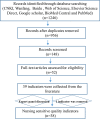Nursing-sensitive quality indicators for pernicious placenta previa in obstetrics: A Delphi study based across Chinese institutions
- PMID: 33960732
- PMCID: PMC8510706
- DOI: 10.1002/nop2.895
Nursing-sensitive quality indicators for pernicious placenta previa in obstetrics: A Delphi study based across Chinese institutions
Abstract
Aim: To identify a set of scientific, systematic and clinically applicable nursing-sensitive quality indicators for pernicious placenta previa (PPP).
Design: A modified Delphi-Consensus Technique.
Methods: According to literature retrieval published between 2009-2019, 38 nursing-sensitive quality indicators were chosen and a questionnaire was designed. An online survey was conducted in 20 hospitals in China, and data of experts' opinions were collected and analysed by improved Delphi method.
Results: 38 nursing-sensitive quality indicators were identified. The response rates in the two rounds of expert consultation were 97.4% and 100%, and the authoritative coefficients were 0.89 and 0.92. The coefficients of variation ranged from 0.04-0.28. The nursing-sensitive quality indicators were successfully constructed based on the modified Delphi technique.
Keywords: modified Delphi technique; nursing-sensitive quality indicators; obstetrical nursing; pernicious placenta previa.
© 2021 The Authors. Nursing Open published by John Wiley & Sons Ltd.
Conflict of interest statement
No conflict of interest has been declared by the authors.
Figures
Similar articles
-
Construction and evaluation of nursing-sensitive quality indicators for vaginal birth after cesarean: A Delphi study based on Chinese population.Heliyon. 2023 Oct 21;9(11):e21389. doi: 10.1016/j.heliyon.2023.e21389. eCollection 2023 Nov. Heliyon. 2023. PMID: 37885709 Free PMC article.
-
Establishing nursing-sensitive quality indicators for the operating room: A cross-sectional Delphi survey conducted in China.Aust Crit Care. 2017 Jan;30(1):44-52. doi: 10.1016/j.aucc.2016.04.003. Epub 2016 May 6. Aust Crit Care. 2017. PMID: 27160417
-
Construction of nursing-sensitive quality indicators for acute poisoning in emergency departments: An e-Delphi study.J Adv Nurs. 2024 Nov;80(11):4736-4749. doi: 10.1111/jan.16266. Epub 2024 Jun 14. J Adv Nurs. 2024. PMID: 38874460
-
Construction of nursing-sensitive quality indicators for epilepsy in China: A Delphi consensus study.Seizure. 2023 Apr;107:71-80. doi: 10.1016/j.seizure.2023.03.012. Epub 2023 Mar 20. Seizure. 2023. PMID: 36989923 Review.
-
Consensus on Quality Indicators for Pediatric Oncology Nursing Care in Mainland China: A Delphi Method and Analytic Hierarchy Process.J Pediatr Hematol Oncol Nurs. 2022 Sep-Oct;39(5):326-334. doi: 10.1177/27527530211068727. Epub 2022 Jan 15. J Pediatr Hematol Oncol Nurs. 2022. PMID: 36129888 Review.
Cited by
-
Development and psychometric evaluation of self-management scale for pregnant woman with gestational diabetes mellitus in China.Nurs Open. 2022 May;9(3):1757-1765. doi: 10.1002/nop2.1202. Epub 2022 Feb 27. Nurs Open. 2022. PMID: 35224873 Free PMC article.
-
Construction and evaluation of nursing-sensitive quality indicators for vaginal birth after cesarean: A Delphi study based on Chinese population.Heliyon. 2023 Oct 21;9(11):e21389. doi: 10.1016/j.heliyon.2023.e21389. eCollection 2023 Nov. Heliyon. 2023. PMID: 37885709 Free PMC article.
-
Development of a risk assessment scale for perinatal venous thromboembolism in Chinese women using a Delphi-AHP approach.BMC Pregnancy Childbirth. 2022 May 21;22(1):426. doi: 10.1186/s12884-022-04700-4. BMC Pregnancy Childbirth. 2022. PMID: 35597914 Free PMC article.
-
Construction of haemodialysis nursing-sensitive quality indicators based on Donabedian theory: A Delphi method study.Nurs Open. 2023 Feb;10(2):807-816. doi: 10.1002/nop2.1349. Epub 2022 Aug 30. Nurs Open. 2023. PMID: 36040112 Free PMC article. Review.
-
Anxiety and depression among perinatal women during the long-term normal prevention of COVID-19 pandemic period in China: a cross-sectional study.BMC Psychiatry. 2023 Jun 21;23(1):451. doi: 10.1186/s12888-023-04930-6. BMC Psychiatry. 2023. PMID: 37344824 Free PMC article.
References
-
- Boatin, A. A. , Schlotheuber, A. , Betran, A. P. , Moller, A. B. , Barros, A. J. D. , Boerma, T. , Torloni, M. R. , Victora, C. G. , & Hosseinpoor, A. R. (2018). Within country inequalities in caesarean section rates: Observational study of 72 low and middle income countries. BMJ Clinical Research, 360(k55), 1–14. 10.1136/bmj.k55 - DOI - PMC - PubMed
-
- Chitkara, A. , Siwatch, S. , Bagga, R. , Saha, S. C. , & Singh, T. (2020). Cervical length monitoring in placenta previa to predict emergency cesarean section for antepartum hemorrhage. Obstetrics & Gynecology, 135, 136S. 10.1097/01.AOG.0000664732.00043.b9 - DOI
-
- Chunxiu, Z. , Xuemei, F. , & Zhu, Z. (2018). Construction of nursing quality sensitive index of midwifery. Chinese Journal of Modern Nursing, 24(8), 964–967. 10.3760/cma.j.issn.1674-2907.2018.08.025 - DOI
MeSH terms
LinkOut - more resources
Full Text Sources
Other Literature Sources


